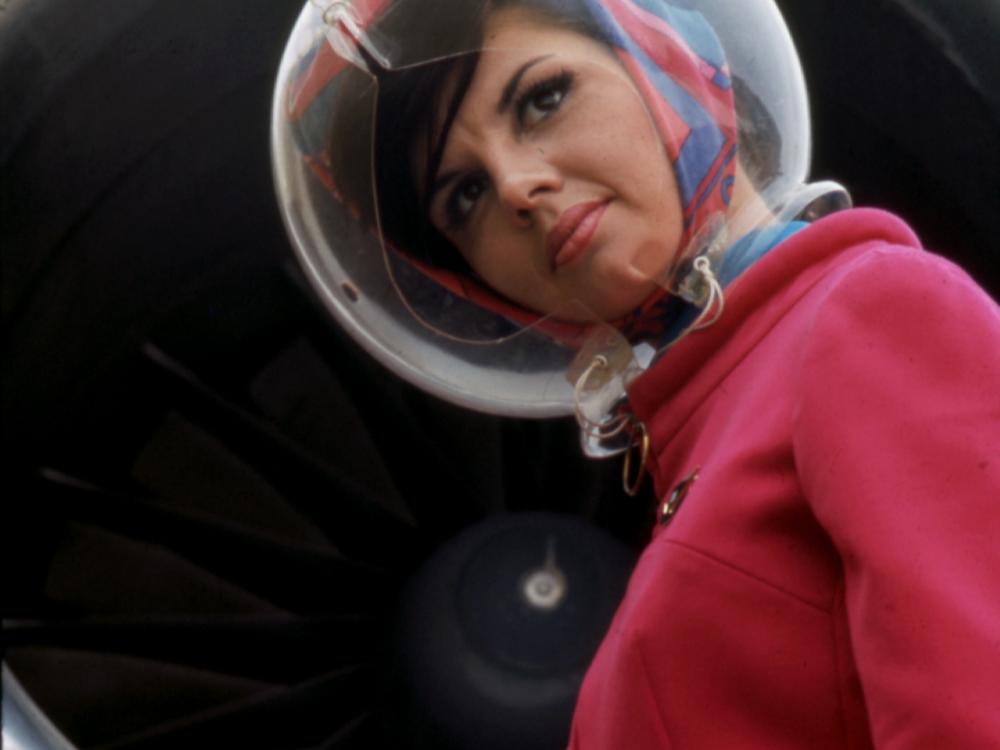
Dec 07, 2021
What happened when women’s fashion became a profitable marketing tool for airlines?
In the 1960s and 70s, as more people began to fly, the popularity of air travel provoked fierce competition. Air fares were regulated by the government until 1978, which meant airlines needed to look for ways other than low fares to attract passengers, especially businessmen, who made up a large portion of passengers in this period. They offered such amenities as better food, drinks, and movies. “Service fit for a king and queen,” American Airlines declared. United countered with their “Red Carpet service.”
Airlines also turned to another way to distinguish themselves: what their flight attendants wore. Braniff advertising executive Mary Wells explained to Business Week in 1967, “When a tired businessman gets on an airplane, we think he ought to be allowed to look at a pretty girl.” However, many flight attendants themselves were unhappy to be exploited. Paula Kane, a flight attendant, commented in 1974: "I didn’t want to put my uniform on, and when I finally forced myself to, I felt worthless, an object…." She recounted how the introduction of revealing uniforms correlated with an increase in harassment. Kane and others came together to advocate for safer, better working conditions for flight attendants.
In this period of competition over the best amenities, commercial airlines made a splash by marketing themselves through what their (mostly female) flight attendants wore. Uniforms evolved from conservative and military in appearance to colorful and stylish. To appeal to male travelers, airlines chose revealing uniforms rather than practical ones, to the discomfort of most flight attendants. These fashion changes taken up by the airlines reflected the changing social attitudes of the 1960s and 1970s, as well as how airlines could use them as a marketing tool.
Braniff Airways was one of the first airlines to adopt new styles. Advertising executive Mary Wells transformed Braniff Airways’ image in the mid-1960s with her “End of the Plain Plane” campaign. She hired noted fashion designer Emilio Pucci to create a new line of flight attendant uniforms. Pucci designed several outfits with bold, brash colors. Braniff also introduced brightly colored aircraft. The plastic bubble helmet, seen in the image below, supposedly protected hairdos on windy tarmacs.
Other airlines followed suit. Air California introduced Mexican-inspired uniforms designed to reflect California’s Spanish heritage, while also incorporating 1960s fashions. Flight attendants ended up wearing sombreros and capes along with miniskirts and go-go boots.
In 1968, United hired noted Hollywood fashion designer Jean Louis to create a stylish line of flight attendant uniforms. The uniforms came in multiple bright colors.
Unlike women’s uniforms, those worn by male flight crew members did not often factor into the airlines’ marketing campaigns and remained mostly unchanged during the 1960s. Furthermore, while pilots were mostly male, the number of male flight attendants decreased drastically during the 1950s and 1960s—as airlines realized that using attractive female flight attendants would attract more customers (who were mostly male).
The flashy uniforms used for marketing wouldn’t last. Conservative uniform styles reappeared following new laws that prohibited discrimination in hiring based on age, appearance, and gender. Moreover, after airlines were deregulated in 1978, they were free to compete by offering low fares, frequent service, and more routes—and they no longer felt the need to hire exclusively attractive young women as flight attendants to market themselves. Business-style uniforms returned to the skies. Uniforms were designed to be comfortable and functional rather than to appeal to the male gaze. Uniforms continued to reflect changes in who were selected to be flight attendants. By the early 1990s, United had become the first airline to issue an official maternity uniform for its female pilots. With flight attendants less focused on how they looked, employee productivity increased.

We rely on the generous support of donors, sponsors, members, and other benefactors to share the history and impact of aviation and spaceflight, educate the public, and inspire future generations. With your help, we can continue to preserve and safeguard the world’s most comprehensive collection of artifacts representing the great achievements of flight and space exploration.
We rely on the generous support of donors, sponsors, members, and other benefactors to share the history and impact of aviation and spaceflight, educate the public, and inspire future generations. With your help, we can continue to preserve and safeguard the world’s most comprehensive collection of artifacts representing the great achievements of flight and space exploration.